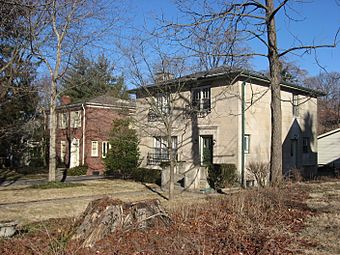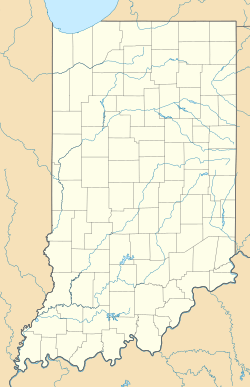Vinegar Hill Historic District facts for kids
Quick facts for kids |
|
|
Vinegar Hill Historic District
|
|

Houses in the district
|
|
| Location | E. 1st St. from Woodlawn to Jordan and S. Sheridan to E. Maxwell, Bloomington, Indiana |
|---|---|
| Area | 21 acres (8.5 ha) |
| Architect | Alfred Grindle, et al. |
| Architectural style | Multiple |
| NRHP reference No. | 05000195 |
| Added to NRHP | June 17, 2005 |
The Vinegar Hill Historic District is a special historic area and neighborhood in Bloomington, Indiana, United States. Most of its buildings were built between 1925 and 1950. This neighborhood is just a short distance south of the Indiana University Bloomington campus. Many important professors from Indiana University have lived here. Vinegar Hill is known for its unique homes and has even been featured in books. It is officially recognized as a historic site.
Contents
How Vinegar Hill Was Built
In the 1920s, the limestone business in Bloomington grew very fast. This made limestone company owners rich. It also created a big need for skilled stonecutters in the city. As the limestone industry became super important, an apple orchard was removed. This made space to extend First Street up a long hill. This new area was then planned out for a new neighborhood.
Many neighborhoods in Bloomington had names related to their location, like "Prospect Hill." People say that the apples from the orchard used to ferment, creating a strong smell like vinegar. That's how the neighborhood got its name!
The first families to build homes here were stonecutters. Many of them were immigrants from Europe. The Donato family was one of the most important. They built seven big houses in the neighborhood. Because so many residents were skilled stoneworkers, they decorated their homes with amazing carvings and sculptures. These decorations would have been too expensive for most people.
At the top of Vinegar Hill were the large houses of the wealthy limestone company owners. Like the workers' homes, these mansions also had fancy stonework. Some even had carvings of the homeowners' children. Other famous people who lived in Vinegar Hill included Indiana University professors. These included Alfred Kinsey, music dean Winfred Merrill, and Nobel Prize-winning biology professor Hermann Muller.
The Unique Look of Vinegar Hill Homes
Since many people in Vinegar Hill worked with limestone, they naturally used it to build their own houses. They used this strong stone to create homes in many different styles. These styles included American Craftsman, Neoclassical, and Art Deco.
Inside, the houses were also very decorative. Many had carved stone mantels (the shelves above fireplaces) and balusters (the fancy posts holding up stair railings). The four houses built by Christopher Donato also had detailed transoms (windows above doors) and lintels (beams above openings).
The grandest houses in the neighborhood are at the top of the hill, towards the eastern end. Here you can find styles like Tudor Revival and Georgian-inspired Colonial Revival. Many homes throughout the district are in different forms of Colonial and English Revival styles. Several Spanish Colonial Revival homes are also very important, especially lower down the hill. The novel The Stone Diaries by Carol Shields even features the architecture of Vinegar Hill as part of its story.
What makes this neighborhood even more special is the amazing lawn decorations around many houses. You can see detailed carvings of people, lions, and griffins. These sculptures make Vinegar Hill truly unique. It's the only neighborhood in all of Indiana where lawn decorations are a major part of its historic charm.
Becoming a Historic Place
Between 1999 and 2001, experts worked with the city of Bloomington to study all the buildings. They found over two thousand buildings that were considered historic. Most of these were grouped into special historic districts.
Vinegar Hill became one of these districts, with sixty-one buildings called "contributing properties." This means they help make the district historic. These buildings were put into three groups: "Outstanding," "Notable," and "Contributing."
- Outstanding properties were so important they could be listed on the National Register of Historic Places by themselves.
- Notable properties were very special but probably not important enough for their own national listing.
- Contributing properties were important parts of their historic district but not super significant on their own.
Eight of Vinegar Hill's properties were rated "Outstanding," and thirteen were "Notable." Only thirty-one were simply "Contributing." This shows that Vinegar Hill has a lot more important historic buildings than other areas. About 40% of its buildings were "Notable" or "Outstanding," compared to only 13% citywide. Having eight "Outstanding" properties was especially rare, making up one-eighth of all such buildings in the entire city!
In 2003, people started working to get Vinegar Hill recognized nationally. The city even received a special grant (money) from the state government to help the district. A class at Indiana University began collecting detailed information about the houses. They also interviewed many residents to get support for the nomination. More and more people wanted the neighborhood to get federal recognition. Finally, Vinegar Hill was officially added to the National Register of Historic Places on June 17, 2005.
The city's historic district includes fifty-two contributing buildings. However, the area recognized by the federal government is even larger. It includes seventy-one contributing buildings and thirty-eight other historic sites, structures, and objects.
Images for kids























































